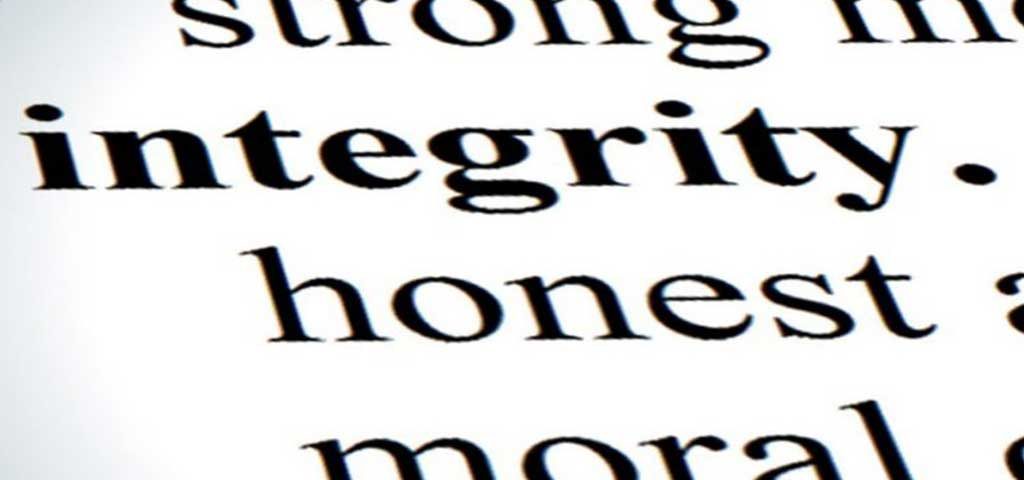
Because Integrity Matters
October 21, 2016
Integrity Programs: What Are We Waiting For?
October 21, 2016By Jeffery Stern
Some pretty important and notable people have weighed in on the importance of integrity. Author C.S. Lewis noted, “Integrity is doing the right thing, even when no one is watching.”
President Dwight Eisenhower said, “The supreme quality for leadership is unquestionably integrity. Without it, no real success is possible, no matter whether it is on a section gang, a football field, in an army, or in an office.”
“The greatness of a man,” singer Bob Marley said, “is not in how much wealth he acquires, but in his integrity and his ability to affect those around him positively.”
The modern official faces more scrutiny than at any time in history. There’s no more hiding under a bushel basket, whether working a game or in everyday life. And one slip-up by one official results in the entire industry being painted with a broad brush of mistrust, disgrace and anger.
Think that’s hyperbole? Here are two words for you: Tim Donaghy.
Other industries have integrity programs. Dave Dodge, Hugh Greeley and Cindy Moore think our industry should have one, too. That trio presented the reasons and the blueprint for an integrity program during a bonus session at the 2015 NASO Sports Officiating Summit in St. Louis.
Greeley and Dodge formed Sports Officiating Consulting, LLC. Greeley is senior consultant and Dodge is CEO. For more than 35 years Greeley has provided consultation and educational services to complex organizations in a myriad of industries. Dodge was a 30-year basketball referee in the Atlantic Coast and Southeastern conferences. Now retired from the court, he is former president and CEO of a South Carolina-based health-care risk management services company, a past NASO board member and the 2010 Mel Narol Medallion Award recipient. Moore is employed by PHT Services Ltd.
She manages the corporate integrity program and has been responsible for investigations, auditing, training and administration.
The speakers were introduced by NASO president Barry Mano, who noted that, despite the reviled Donaghy, there is not an integrity crisis in officiating. “But there have been some concerns, especially when we accept the fact that our integrity is the very cornerstone of the responsibilities that we carry out, that higher standard that we are expected to adhere to,” Mano said.
Dodge referred to sports-related scandals outside of officiating — and there have been plenty — and asserted that they can and should have been avoided had an integrity program been in place. “One need only look at the defense industry, health care, financial services and many other sectors of the economy,” Dodge said. “All have taken progressive steps in their industries to establish corporate compliance or integrity programs which are geared toward preventing small problems from growing into large ones.”
Key Elements
So how would an association set up a program? An effective integrity program consists of three parts. One part is what Greeley called an early warning system. “It’s a system in place that allows you to constantly know what all of your stakeholders would like you to know,” he said.
Such a policy would have prevented embarrassment to the association that assigned an official to its premier event only to find out the official had been accused of killing her husband. “Had that organization maintained a committed integrity program, someone … would’ve alerted them. They were entirely unprepared for the press coverage, and when asked about it they made comments that in retrospect they never would’ve made had they known about it,” Greeley said.
Most professions and industries have a formal integrity program. Has the time come for officiating to adopt its own?
The official was cleared of the charges, but the damage was done.
Another must-have facet is a code of conduct, one “that is constantly waved around and used as part of an organized program,” Greeley said.
Such a code should spell out what behavior is required as well as what is not acceptable. Greeley used small engine manufacturer Briggs and Stratton as an example. That company’s website includes a link to its code of conduct. Topics covered include prohibitions on child and forced labor as well as discrimination and policies on compensation and confidentiality.
“Designing a code of conduct sitting in your own office by yourself is not nearly as beneficial as enlisting the support of lots of stakeholders, because it brings them into the process,” Greeley said. “It is not quite so much what you do as how you do it, as how you say it if you’re trying to move the organization in the direction of an organized integrity program.”
“You also are stating in your code of conduct that you are responsible for enforcing and ensuring compliance,” Moore added. “There should be language in there discussing that investigations are conducted, results of investigations could lead to specific actions up to and including termination.”
Stakeholders must be able to access bylaws, codes of conduct and other key documents. “Getting them all compiled, organization wide, into one space that you have access to (is crucial),” Moore said. “In my organization we have created some very simple templates that record policies in a very standardized way. There’s a purpose for the policy, who it applies to, any legal obligations associated with the policy and then what the policy is. We maintain those electronically. It’s a very easy way to make sure that everything is up to date.”
The third facet is confidentiality, which Greeley said is especially crucial. Those in an organization who wish to make the powers aware of missteps by peers must know their identities will be protected.
“Up until very recently, nurses would not report an error that a physician had made for fear that they would lose their job,” Greeley said. “It’s taken 20 years in the health-care industry for that fear to be broken down to the point that we now have a system that is bringing to the forefront instances that we need to know about to improve care. The same is true in officiating. Not with the same outcome as improving care, but maintaining the reputation of the organization and the integrity of the sport for you is equally important as improving the quality of care is to a nurse or to a physician.”
Greeley used the real-world examples of officials who cheat on an exam, are observed participating in illegal or unethical behavior or are working under the influence of alcohol or drugs. We like to think it wouldn’t happen, but it does. “Remember, all of those issues are not reported, for a host of reasons,” Greeley said. “A very significant one is the fear of reprisal. In all industries, people are terribly worried about reporting something for fear of reprisal.” When a breach of the code is brought to light, the organization must conduct a thorough investigation. If violations are brought to light, they must be corrected.
“Correction is sometimes as easy as, ‘We just don’t work that way,’” Greeley said. “It’s a casual comment, if it’s detected early and if the issue is at a minor stage.”
Moore suggested a survey to gauge the concerns of a group. It will provide a format for officials to share any important feedback. “Create a survey that asks them to report to you things that are going on that no one is really bringing forward,” she said. “You don’t do those every month, certainly. Probably an annual survey to get feedback from your association is a good idea. At the beginning, a survey is a very good tool to discover what sort of conduct is out there that is not currently being reported.”
In terms of officiating, lack of integrity can manifest itself in word as well as deed.
An official who spreads uninformed gossip, speaks ill of peers or complains about assignments casts a negative light on the industry. A proper integrity program will give an association or agency a chance to keep those comments and address the problems in-house. As a result, it helps to protect the reputation of the association and the officiating industry.
“Knowing that allows you at the very least to engage in a conversation to bring your knowledge to the attention of the person and to see what the root cause is of their dissatisfaction. And it may lead to other actions as well,” Greeley said.
Birth of an Integrity Program
Instituting an integrity program should be proactive, not reactive. Someone needs to take the lead, Greeley said.
“It takes a champion,” he said. “If you have a volunteer free clinic serving the uninsured, it just didn’t happen. A nurse, a physician, a business leader … shone a light on it. You must be that champion, or you must find that champion to pioneer and push this program along.”
Integrity programs are not created overnight. And they do not succeed without buy-in. The champion official must make a compelling case to the leaders in the association. “Gain top management commitment by doing a kind of self assessment,” Greeley said. “Present that to your organization. Show them the holes in your existing program. Show how easy it would be to plug those holes and have a more effective program.”
Although Greeley used a number of large companies to further his point, size does not matter when it comes to integrity programs. “Make no mistake,” he said, “the size of an organization never excuses them from having an effort on integrity. It could be three people. It’s just a little bit easier because there are fewer moving parts. The larger the organization, the more moving parts there are, and the more complex the program will be.”
The key player in an integrity program is the integrity officer, whose duties are to prevent, detect and correct illegal and unethical conduct. Moore described an ideal candidate as a management-level leader in the organization, who has some analytical abilities and experience with audits, yet is approachable and visible in the organization.
“You may have an idea of who that might be,” Moore said. “It could be you. Maybe there’s someone else in your organization that you think could play a good role there. It does take someone, though, that has an investigative function, maturity level, and a trusted colleague in your organization.”
Dealing with officials at the amateur level means dealing with independent contractors. While companies can more easily compel employees to toe the line, independent contractors are not as easily controlled. More challenging, but it is not impossible. He pointed to the U.S. Tennis Association as an organization that has “a great code of conduct that applies to all independent contractors,” Greeley said. “It’s working better and better as time goes on. There is no question that an organization dealing with independent contractors can bind those independent contractors to a code of conduct.”
Jeffrey Stern is Referee’s senior editor. He is a veteran high school baseball umpire and high school and collegiate football official.


